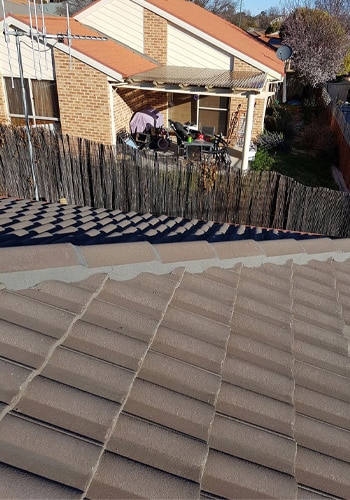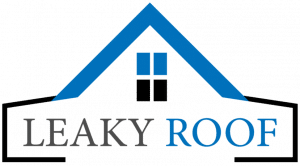Rebed and Repoint Ridge Capping
If you notice damage to your ridge capping or the mortar that holds the ridge capping to your tiled roof, you should get this fixed before you end up extensive water-damage inside your home.
Book $99 Inspection

What is Ridge Capping?
Ridge capping is a roofing material used to cover the ridge line of a tiled roof. It is typically made from the same type of material as the roof tiles, such as terracotta or concrete, and is shaped to fit over the ridge line.
The ridge capping helps to seal and protect the joint between two adjacent roof slopes and prevent water leakage. It is installed by overlapping the ridge cap pieces and securing them to the roof with mortar. Ridge capping is an essential component of a well-constructed and durable roof.
Signs of Ridge Capping Damage
Damaged ridge capping can present signs of wear and tear that shouldn’t be ignored. When inspecting your roof, it’s important to be aware of these signs as they indicate the need for rebedding and repointing of the ridge capping. The most common signs are:
- Visible cracks or gaps.
- Loose or dislodged ridge caps.
- Crumbling or eroded mortar around the ridge caps
Being vigilant about signs of damaged ridge capping is crucial in maintaining a structurally sound roof. Ignoring these signs can lead to costly repairs as water damage spreads throughout your home.
Importance of Rebedding and Repointing
One crucial aspect of roof maintenance is rebedding and repointing the ridge capping. This process involves removing old mortar, replacing it with new bedding material, and repointing the ridge caps to create a strong seal.
There are three reasons why is rebedding and repointing so important:
- Preventing Water Leaks: Weather conditions cause the bedding material to deteriorate over time, leading to gaps between the ridge caps and roof tiles. These gaps allow water to seep inside, potentially causing leaks and water damage to your home’s interior.
- Maintaining Structural Integrity: The ridge capping is a protective barrier against wind uplift forces that can loosen or dislodge roof tiles. Ensuring the ridge capping is properly bedded and pointed reinforces your roof’s structural integrity.
- Increasing Roof Lifespan: Regularly rebedding and repointing your ridge capping helps extend your roof’s lifespan by preventing further damage caused by loose or cracked mortar. It also minimises the risk of more extensive repairs in the future.
It’s advised to seek professional assistance such as Leaky Roof, experienced roofers specialising in roofing maintenance.

Process of Rebedding and Repointing
Rebedding and repointing refer to replacing or repairing the cement mortar that holds ridge capping in place on your roof. This is an essential part of roof restoration.
- Remove any loose or deteriorated mortar from the ridge capping.
- Apply fresh bedding mix along the length of the ridge capping.
- Reposition each piece of ridge capping onto the bedded mix.
- Use a flexible pointing compound to repoint the ridge capping.
By following this step-by-step process of rebedding and repointing with proper materials like cement mortar and flexible pointing compound, you can ensure that your roof remains stable, leak-free, and protected for years.
Cost of Rebedding and Repointing
The expense of rebedding and repointing can vary depending on the size and condition of your roof, but it’s a crucial investment to protect your home from potential leaks.
There are several factors to consider when it comes to the cost of rebedding and repointing.
- Materials: the material used for rebedding and repointing plays a significant role in determining the overall cost. If your roof is made of terracotta tiles, the cost may be higher than other materials, such as cement. Terracotta requires specialised skills and tools for rebedding and repointing, which can contribute to higher expenses.
- Size of the roof: the size of your roof. Larger roofs require more time and materials for rebedding and repointing, which can increase the overall cost.
- Damage: if your roof has extensive damage or deterioration, it may require more work, leading to higher costs.
It’s important to note that while rebedding and repointing may seem like an upfront expense, it can save you money in the long run. You can prevent costly water damage and structural issues by investing in proper maintenance and repairs.
FAQs
How often should ridge capping be rebedded and repointed?
Ridge capping should be rebedded and repointed every 10-15 years. Regular inspections can help identify any signs of deterioration or damage that may require earlier intervention.
Can ridge capping damage lead to other issues with the roof?
Ridge capping damage can lead to various roof issues. It may cause water leaks, structural instability, and mould growth if not addressed. Regular inspection and maintenance of ridge capping are crucial to avoid further complications.
What materials are typically used for rebedding and repointing ridge capping?
To rebed and repoint ridge capping, a cement-based mortar mix is used. This material provides durability and helps to secure the ridge capping, preventing any potential damage or leaks on your roof.
Is DIY rebedding and repointing ridge capping possible, or should a professional be hired?
Hiring a professional for rebedding and repointing ridge capping is highly recommended. This task requires specialised knowledge, skills, and tools to ensure proper installation and long-lasting results.
